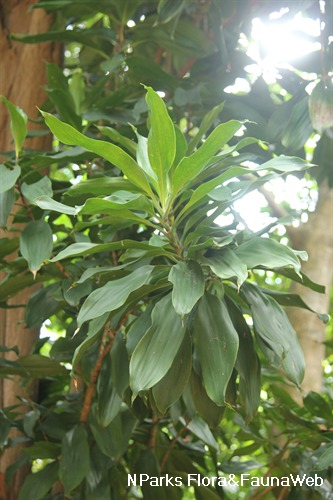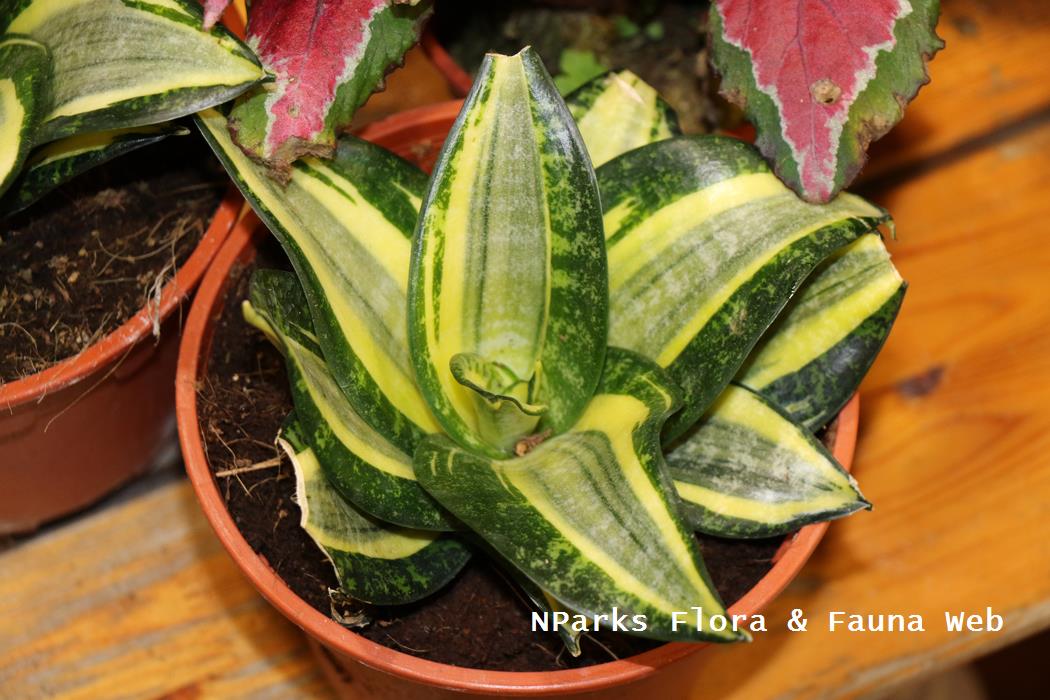
Name
Classifications and Characteristics
| Plant Division | Angiosperms (Flowering Seed Plants) (Monocotyledon) |
|---|---|
| Plant Growth Form | Shrub |
| Lifespan (in Singapore) | Perennial |
| Mode of Nutrition | Autotrophic |
| Plant Shape | Columnar |
Biogeography
| Native Habitat | Terrestrial |
|---|
Description and Ethnobotany
| Growth Form | A slender yet hardy, multi-stemmed, understorey shrub with attractive, erect to spreading, flexible, strap-shaped leaves that crowd toward the apex of the stems or spaced along part of the stems. |
|---|---|
| Foliage | Leaves simple, entire, sessile (attached directly by the base to the stem; without any stalk), usually strap-shaped to elliptic-lanceolate, crowded toward apex of stems or spaced along distal parts of stems, green (usually with variegation of different kinds in cultivars). |
| Stems | Stems simple or branched, green, glabrous (smooth; not rough or hairy). |
| Flowers | Inflorescences branched,clustered, terminal, cream. |
| Fruit | Fruits are berries, globose (shaped like a globe; round), 1 to 3 seeded. |
| Cultivation | It prefers bright, indirect sunlight with moderate amount of water. Strong, direct sunlight may scorch the waxy, green leaves, or turning them yellow. Should the plant becomes etiolated or the foliage starts to fade its colour, provide brighter lighting to ameloriate these problems. It likes well-drained, rich potting soil with monthly doses of very weak fertliser. Plant can be rotated when stems are leaning towards one side to light source. Prune plant occasionally to attain a bushier appearance. Propagate by cuttings. Caution: Plant may be poisonous to pets if ingested. |
| Etymology | The genus epithet 'Dracaena' means 'female dragon' in ancient Greek, and is derived from the word 'drakaina', in probably reference to the milky juice of 'Dracaena draco', another species within the genus, which dries to a resinous powder used as a colorant, 'dragon's blood'. In mythical explanation, Ladon, the hundred-headed dragon and guardian of the Garden of the Hesperides, was killed by Hercules (or Atlas, depending on the version told) in attempt to collect three golden apples to complete the eleventh of his twelve labours, and that dragon trees sprung from where Ladon's red blood flowed. This fabled garden is allegedly an island beyond the Atlas Mountains, which seemingly points to the Canary Islands and 'Dracaena draco' as being the basis for this myth. The species epithet 'sanderiana' is honoured after German-English gardener, Henry Frederick Conrad Sander (1847 - 1920). |
Landscaping Features
| Desirable Plant Features | Ornamental Foliage |
|---|---|
| Landscape Uses | Interiorscape/ Indoor Plant, Container Planting |
| Thematic Landscaping | Zen / Minimalist Garden |
| Usage Hazard - Cons | Toxic Upon Ingestion |
Plant Care and Propagation
| Light Preference | Semi-Shade |
|---|---|
| Water Preference | Moderate Water |
| Plant Growth Rate | Moderate |
| Rootzone Tolerance | Easy to Grow |
| Propagation Method | Stem Cutting |
Foliar
| Foliage Retention | Evergreen |
|---|---|
| Mature Foliage Colour(s) | Green, Yellow / Golden, White |
| Mature Foliage Texture(s) | Leathery |
| Prominent Young Flush Colour(s) | Green, White, Yellow / Golden |
| Young Flush Texture(s) | Leathery |
| Foliar Type | Simple / Unifoliate |
| Foliar Attachment to Stem | Petiolate |
| Foliar Shape(s) | Non-Palm Foliage |
| Foliar Venation | Parallel |
| Foliar Margin | Entire |
| Foliar Apex - Tip | Acuminate |
| Leaf Area Index (LAI) for Green Plot Ratio | 3.5 (Shrub & Groundcover - Monocot) |
Floral (Angiosperm)
| Flower Colour(s) | Cream / Off-White |
|---|---|
| Flower Grouping | Cluster / Inflorescence |
| Flower Location | Terminal |
Fruit, Seed and Spore
| Fruit Classification | Simple Fruit |
|---|---|
| Fruit Type | Fleshy Fruit |
Image Repository
Others
| Master ID | 671 |
|---|---|
| Species ID | 1966 |
| Flora Disclaimer | The information in this website has been compiled from reliable sources, such as reference works on medicinal plants. It is not a substitute for medical advice or treatment and NParks does not purport to provide any medical advice. Readers should always consult his/her physician before using or consuming a plant for medicinal purposes. |





